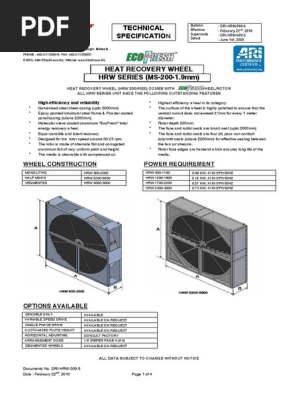Dehumidification: To remove moisture from the air or a gas.
- Bry Air Heat Recovery Wheel
- Bry Air Heat Recovery Wheel Software Systems Inc
- Heat Recovery Wheel Calculation
- Bry Air Heat Recovery Wheel Software Systems Reviews
- Bry Air Heat Recovery Wheel Software Systems
Bry Air Heat Recovery Wheel Software Spectrum Jo Bhaji Thi Dual Song Download Download Soal Dan Jawaban Tes Psikotes Lengkap.pdf Chess Mortal.kombat Download Download Bioskop Sanubari Jakarta Full Video Adobe Photoshop Cs5 Extended 64 Bit Amtlib.dll Flash Nokia Theme Downlead Clock. Heat pipes for heat recovery. The heat energy in waste air is valuable. With a heat pipe, you can recover most of it for free. Changing the air in occupied buildings has an expensive side-effect: the heat energy that you pumped into the building escapes with the air and the fresh air that replaces it has to be heated afresh.
- Sensible Heat-Recovery Systems. A sensible heat-recovery systems will transfer sensible (dry-bulb) heat from the exhaust air to the supply air entering the building. Rotary wheel heat exchangers and cross flow heat exchangers are some of the common designs used in typical comfort-to-comfort sensible heat-recovery applications.
- Broan HRV200H Heat Recovery Ventilator Parts. Listed below are the parts available for this model. Use the parts explosion image to locate the associated part key number. When you hold your mouse over the parts explosion picture, it should zoom it for a closer look. Once you have found the parts that you need, select the matching part key from.
- Developing Empirical Heat Recovery Wheel The non-standard component, Bry-Air Heat Recovery Wheel Model HRW-900 has been modeled based on actual model from Bry-Air (Malaysia)(Lim P.H., 2008). It is important to mention that the performance data and specification for the product has been obtained from Bry-Air, (Lim P.H., 2008) and the equations.
There are many types of dehumidifiers all with their positives and negatives. It is important to consider these positives and negatives to properly apply a dehumidifier to a space or process.
A. Compression

Bry Air Heat Recovery Wheel


B. Mechanical/Refrigeration
Bry Air Heat Recovery Wheel Software Systems Inc
C. Adsorption Based Desiccants
D. Absorption Based Desiccants
To better understand the process of dehumidification it is important to understand the various types of dehumidification systems on the market today. All of the basic dehumidification types identified above are available but this does not mean that all types are created equal for each particular application.
As air is compressed, the dew point or temperature at which water will condense is raised. Therefore, to get dry air we need to find a way to cool the compressed air. But costs can be prohibitive because equipment, space, and auxiliary equipment are necessary for the process. However, if compressed air is already used in the primary operation and only very small amounts of dry air are needed for humidity control, compression may be a feasible route to dry air. The primary limiting factor with dry air via compression is simply the volume of air required.
Mechanical/Refrigeration based dehumidifiers use either a chilled water/glycol loop or a vapor compression system coupled with an evaporator coil at dew point to condense the water vapor as the air passes through the evaporator. The common systems available on the market today often operate reliably down to approximately 45°F dew point. Below this point the typical mechanical/refrigeration system will begin to have frosting/freezing issues as desired dew point falls below 45°F. Therefore, a mechanical/refrigeration system applied to lower dew point applications will require a defrost cycle during which dehumidification is not taking place.
Heat Recovery Wheel Calculation
Adsorption based dehumidifiers utilize an adsorbent desiccant material such as silica gel or activated alumina to reduce moisture content in the air without a chemical or physical change to the material. Typical systems include a fluted or corrugated media configured in a rotating mass. These systems require reactivation via a heat source to expel moisture via a separate airstream commonly referred to as the reactivation air stream. Typical applications for these units include dew points below 45°F and some manufacturers, including Bry-Air, produce systems that can maintain dew points of -80°F. The common concern with this type of dehumidifier is that reactivation energy transferred coupled with the heat of conversion during the adsorption process increases the air temperature of the process airstream. However, this can be combated with cost effective energy recovery and energy management solutions.
Bry Air Heat Recovery Wheel Software Systems Reviews
Absorption based dehumidifiers utilize an absorbent desiccant material such as calcium chloride to absorb moisture via a chemical change in the material structure. Typical systems utilize storage tanks to hold the liquid based absorption material often diluted with water which is pumped through a spray bar over a media pad. As the moisture laden air comes in contact with the absorption material the chemical change in structure takes place bonding the moisture molecules with the absorbent. The absorption based dehumidifier also requires reactivation to change the material structure causing the absorbed water molecules to be exhausted from the reactivation air tunnel. It is often seen as a benefit that these systems, when using a liquid absorption system, offer some evaporative cooling effects while dehumidifying the air. Potential pitfalls of this system include desiccant carryover and system corrosion (including ductwork), additional maintenance, accurate system control, among other things. It should be noted that there are dry bed/rotor systems available as well, which also utilize the absorption media. However, even in dry form these types of systems often have pitfalls, so caution should be taken in the application of this technology.
Bry Air Heat Recovery Wheel Software Systems
Some of the best systems available today offer a combination of system technologies such as refrigeration coupled with adsorption, as often used by Bry-Air. Contact Bry-Air today to discuss these systems and how they may be applied to your specific moisture control challenge.


